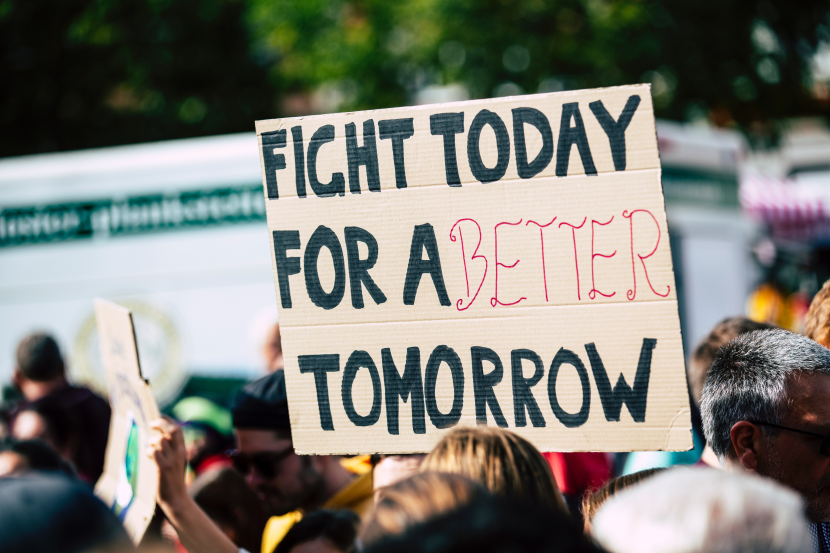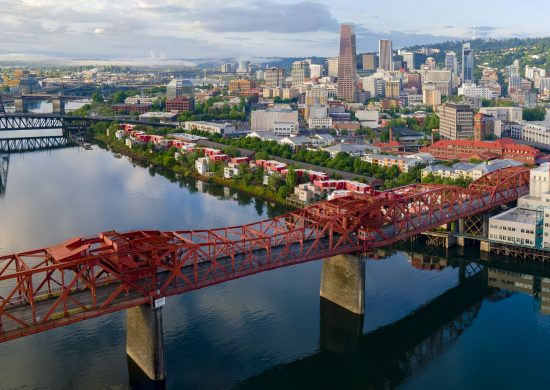By: David Beckman and Fanta Kamakaté

Three years ago, the Pisces Foundation collected its learning and refreshed its environmental strategy Foundation-wide. For the Climate and Energy program, that meant scaling super pollutant mitigation while strengthening strategy in three ways common to the Foundation’s programs: funding a broader set of organizations whose contributions are synergistic and collectively more powerful, enhancing equity by directing more money to the communities disproportionately impacted by climate change and air pollution, and funding movement infrastructure—the shared tools and connections needed to turn the individual efforts of people into population-level social change.
So it made sense that when The Climate Funders Justice Pledge (CFJP) launched two years ago the Foundation was one of the first to commit to the full pledge and to offer its support to the Donors of Color Network to encourage more foundations to come on board. The CFJP has two requirements – funders must commit to greater transparency by sharing their funding percentages to Black, Indigenous, and People of Color (BIPOC)-led groups publicly, and they must give at least 30% of their U.S. climate funding to BIPOC-led climate groups within two years of taking the pledge. For Pisces, taking and meeting the pledge is grounded in the Foundation’s evolving grantmaking to better support how large-scale social changes happen.
In this blog, Pisces Foundation President David Beckman and Climate and Energy Program Lead Fanta Kamakaté dive deeper into why the Foundation’s climate strategy needed to evolve and how that shift initiated a substantial increase in funding toward frontline communities in just a few years.
For more on the importance of building a full movement as part of an effective climate strategy, particularly in light of historic federal climate funding, please check out David’s recent podcast interview on Volts alongside political scientist and social movement scholar Hahrie Han.
What is the Pisces Foundation’s overall approach to tackling climate change?
David: Overall, our view at the Foundation is that the only way to build strong, healthy communities and a planet where people and nature can thrive together is by recognizing that we need both good ideas about how to drive down climate change—where foundations traditionally have directed resources—and we need to generate the advocacy power necessary to make those good ideas into tractable policy. It’s power plus policy that can work to change the complex social systems that have generated the climate crisis. That’s why we shifted to support a broader set of organizations whose collective impact and influence together is greater than any one part of the movement alone.
Equity is essential. The fact that philanthropy resources groups on the frontlines confronting some of the worst impacts of climate change with a fraction of their dollars is simply unfair and perpetuates the effects of racism. How can we acknowledge that many Black and Brown communities have more than their fair share of climate-induced challenges, and less than their fair share of resources?
Something else can be missed in this equation, as well. An inequitable funding strategy is also an ineffective funding approach because it fails to ensure some of our most insightful and effective advocates can do their work. That’s a loss, first and foremost, for many BIPOC communities and for everyone, as Heather McGee persuasively argues in her book, The Sum of Us.
Moreover, movements need infrastructure. Whether on the left or the right, movements that win build the tools and resources—communications, networks, training, and the like—and they invest in it steadily. This is because the “how” of the work, reflected in well-equipped and connected organizations that are resilient and have options when things don’t go well, unlocks the “what,” the win that improves communities. Hahrie Han’s work is very influential in our thinking when it comes to debunking the flawed idea that you can get to big outcomes without steady and meaningful investments in capacity and connection (including bridging between groups not in affinity)—as has been Bridgespan’s important work in assessing the power of field-building as a philanthropic strategy.
How does resourcing frontline communities like those who are the focus of the pledge fit into your strategy on climate?
Fanta: The Climate and Energy program prioritizes efforts to mitigate super pollutants like black carbon, methane, and hydrofluorocarbons today to clean the air, turn down the heat and save lives. And, in line with the framework David just mentioned, our strategy aims to address climate change in this critical ten-year period by bolstering policy advocacy targeting super pollutants, supporting movement-building organizations and those most impacted by air pollution and climate change and strengthening field infrastructure.
Super pollutants are pound for pound more potent than CO2, accelerating warming while significantly contributing to air pollution, killing seven million people globally each year. In the United States, the cumulative impacts of climate change and air pollution are starkest in low-income and communities of color that are on the frontline of polluting industries.
It’s within these communities where some of the most powerful, effective cases and the most ambitious solutions are born. For example, the Moving Forward Network launched its “Zero Emission Now” campaign calling for zero emission freight in 2014, years before it became a mainstream environmental NGO demand and the focus of federal government investment. The network’s ongoing work to ensure “#zeromustmeanszero” holds decision-makers accountable to delivering real-world emissions reductions for communities and the planet. So frontline communities drive effective strategy in two critical places—they are largely the communities that will most immediately benefit from a significant reduction in super pollutants, and they also play a pivotal role in the myriad of targeted policy and power-building solutions we know are necessary to meet this moment.
What does that look like in practice, and what impact are you seeing?
David: One issue area we’ve doubled down on in this approach is methane reduction from the oil and gas sector. We take a systems approach to methane reduction as an entry point to mitigate harmful emissions today, to slow and stop oil and gas infrastructure expansion and ultimately shift away from fossil fuels towards renewable energy equitably. Within this methane focus, Pisces is funding policy development, global negotiations and communications, and significant frontline movement work that benefits local communities and seeks to knit together a powerful mosaic of advocates and activists who can build the power to get at pivotal policy wins.
Fanta: To flush out that mosaic of methane-focused investments a bit more, here are some key pieces. We support the Methane Partners Campaign, a coalition of environmental, health and labor organizations advocating for federal methane regulation. This coalition is co-led by grantee partners Earthworks and GreenLatinos. They have been building the case for a strong and durable rule that protects communities. The campaign is lifting up the voices of those living with methane pollution at hearings and in the media—and it’s resonating. For example, the US EPA’s latest proposal to limit methane emissions from oil and gas productions extended its coverage of low-production wells after a combination of on-the-ground measurements by local campaigners and a national study proved that these wells are responsible for about half the pollution. We are hoping to see the latest set of rules finalized by the end of year. Once rules are on the books, they must be implemented to yield any real-world benefits. That means holding local regulations and the oil and gas industry accountable for delivering on emission reductions – especially given there are currently a number of states with good rules in place that fall short on enforcement.
We are funding a cohort of impactful grassroots organizations in oil and gas-producing regions to build power to do just that, like Pueblo Action Alliance in New Mexico, Carrizo Comecrudo Tribe of Texas and Chispa TX in Texas, Deep South Center for Environmental Justice in Louisiana, and Beaver County United in Pennsylvania. Methane might not be a keyword in their list of priorities. However, their success in holding the oil and gas industry accountable for its pollution and slowing its expansion is essential to cut methane in this decade. And they have found the impacts of methane to be a useful tool in their advocacy. Recent wins include shutting off key investments to LNG infrastructure and pushing back on infrastructure expansion in South Texas, educating lawmakers about oil and gas impacts on communities and their cultural heritage in New Mexico, and securing resources for better air quality monitoring in Louisiana.
Many of these organizations are key members of regional and national coalitions, like People vs. Fossil Fuels—their impact extends beyond their region.
You can see how these puzzle pieces fit together to impact federal, state and local regulations, build power for implementation and accountability to deliver real-world methane reduction and the momentum we need to shift away from fossil fuels.
How did you make these shifts practically speaking?
David: At the end of the day, we were able to realign our grant portfolio in a significant way in a short period of time because we authentically believe every element of our strategy—from boosting equity in our grantmaking to resourcing movement infrastructure to ensuring we’re funding advocacy by a wide range of effective organizations, each capable of making a synergistic contribution and altogether capable of greater collective impact. Each element is vital to strengthen our ability to drive wide-scale social change.
The CFJP numbers are a good example of what that shift can look like in practice. When we first took the CFJP, we were below the 30% threshold at 17%. Now, we’re well over 40%. We shared that first number regardless because we were serious about our commitment to grow; as long as that’s the case, your equitable grantmaking goal is achievable. Pledges have their limits, but they are important catalytically in creating the shift that frontline communities deserve and that we all need to win.
Fanta: To meet the commitments we made in our strategy, we quickly realized we had to grow our knowledge of the field. We needed to invest the time to build more complete landscapes of organizations and how they related to each other and to our shared goals. We made sure that we integrated our updated approach in all strategy discussions across all team communications and with our partners. It was incredibly important that this be at the forefront of all our current work—not as a future goal but as something to drive forward in the immediate.
In practice, we shifted our grantmaking portfolio substantially in this two-year period by:
- Connecting with existing partners to understand how they think about their strategies to engage with communities on the frontlines.
- Talking to other aligned or adjacent funders with similar levels of commitment.
- Engaging with networks, coalitions, and other efforts that serve grassroots organizations.
- Building ecosystem maps to identify groups that may not be on the radar of funders but are essential for the ecosystem to deliver critical wins.
- Approaching prospective grantees with humility and transparency about our intent, goals, and processes.
- Describing to prospective grantees what it would look like to be in partnership with us as a funder.
- Leaning into grantmaking practices that ease grantee burden and build trust.
Implementing this work really came down to two key forces. The first is making the commitment to make a change and remaining steadfast in that commitment. The second is mobilizing internally to grow our knowledge of the field, which requires a willingness to create the space for your grantee partners to share their learnings and then to genuinely incorporate that feedback in overall strategy.
What does your experience hold for other foundations?
David: We’re running out of time to limit warming to 1.5 degrees Celsius. There’s still a misconception among too many in the philanthropic sector that integrating equitable grantmaking is an add-on in the work to tackle our broader environmental crisis. That mindset is hampering our ability to power a coordinated climate response field-wide. Philanthropy, I think, has a responsibility to resource a movement-focused framework that equitably funds frontline organizations in order to build the necessary power to effect critical policy change and halt warming. If we don’t approach the problem holistically, we cannot meet the pace and scale of our climate crisis.
I think our experience holds the opportunity for genuine, deep, and authentic growth for ourselves and for fellow foundations. Reorienting around an updated strategy is not always easy, but it’s possible—and it’s exhilarating to translate learning into action. And the reward on the other side is a dramatic increase in the efficacy of your grantmaking and overall environmental impact.
Fanta: The Foundation has also experienced firsthand the benefits of more participatory grantmaking approaches. Involving grantees and movement experts in the broader conversation enhances strategy, relationships, and potential impact. All key elements of our strategy, including integrating equity and powering a pluralistic movement, become a lot more intuitive when you incorporate a collaborative approach to decision-making.



